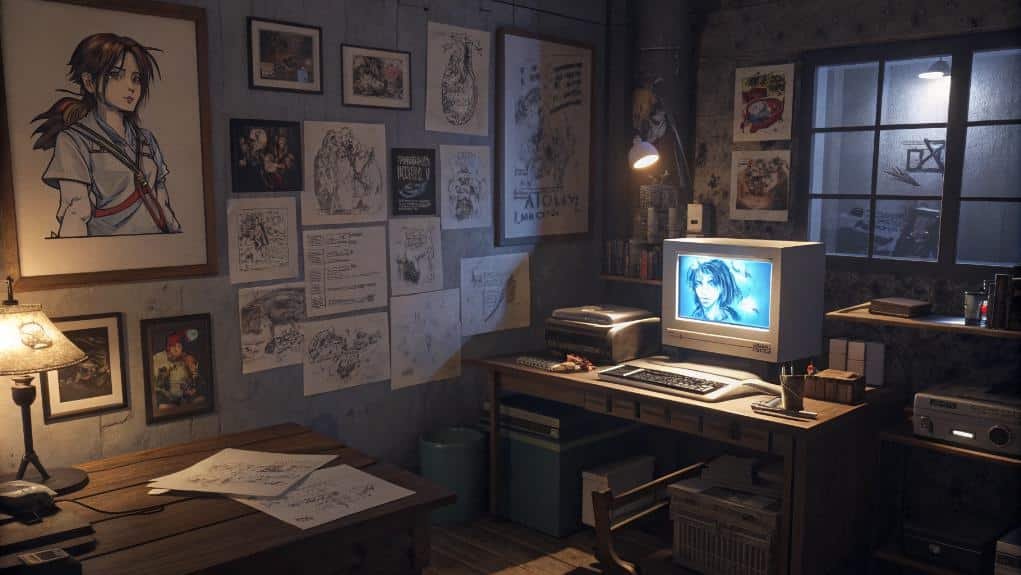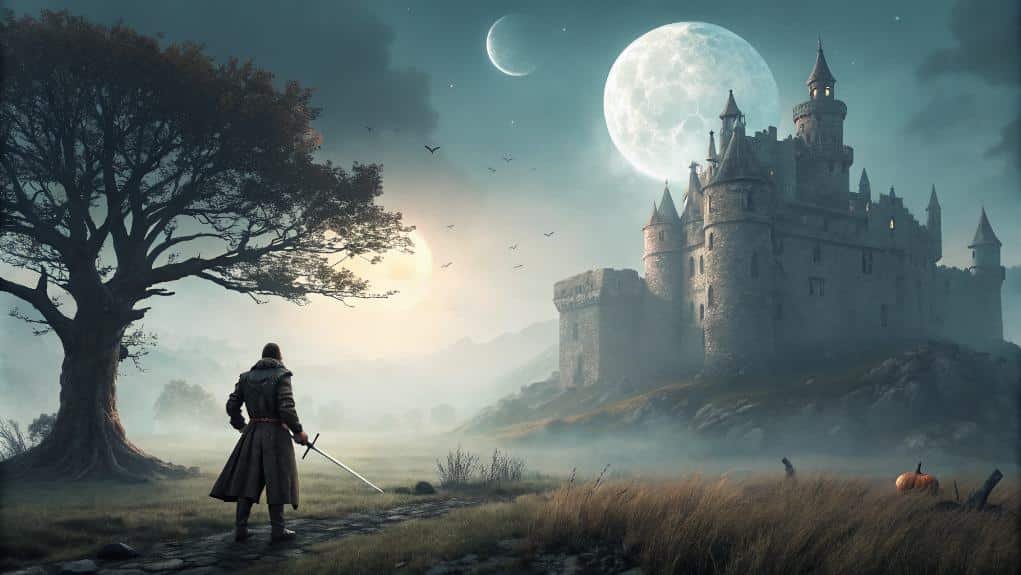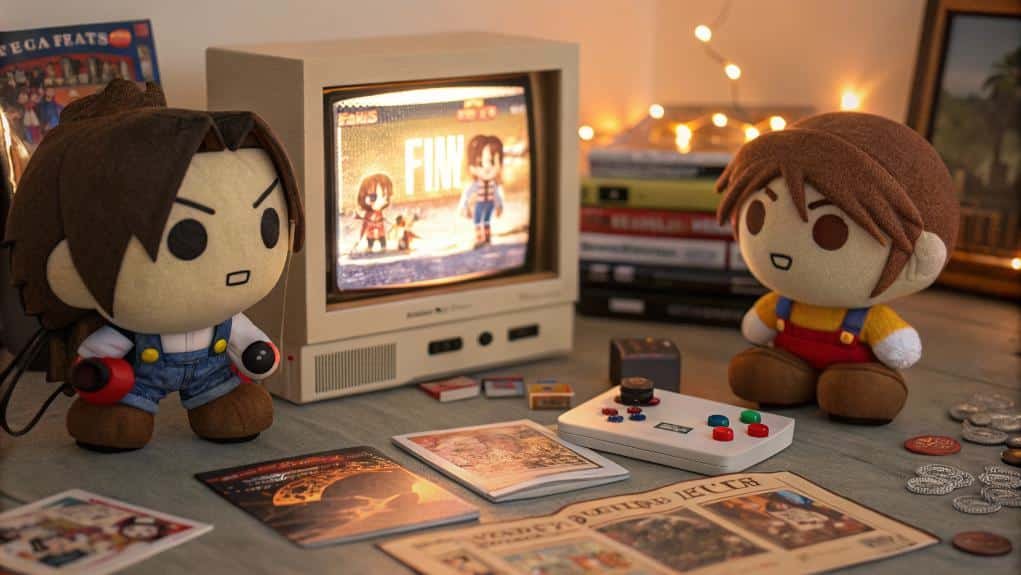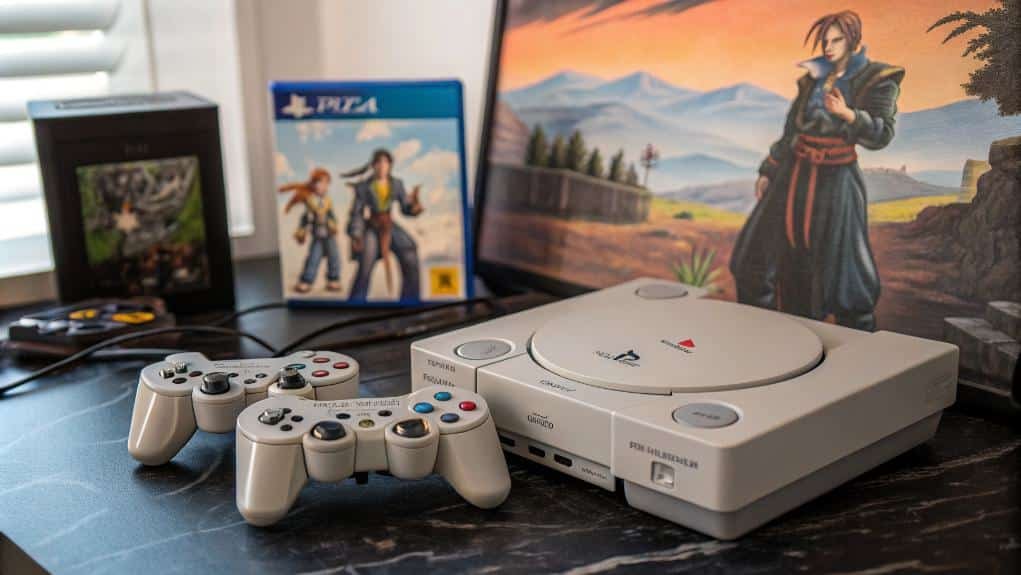Final Fantasy VIII emerged as a defining chapter in the series, emphasizing emotional depth and personal growth through its central figures, Squall and Rinoa. Departing from ensemble casts, it introduced innovative gameplay mechanics like the Junction system, which redefined character customization and strategy. The narrative explored themes of war, trauma, and the complexities of relationships, with Squall's journey serving as a powerful focal point. While initial reception was mixed, its artistic merit has gained recognition over time, solidifying its legacy. The game's rich history reveals much about its influence on the franchise and the gaming landscape overall.
Key Takeaways
- Final Fantasy VIII, released in 1999, focused on Squall and Rinoa's relationship amidst a narrative centered on emotional depth and personal growth.
- The game introduced innovative gameplay mechanics like the Junction system and the Active Time Battle system for strategic combat and character customization.
- Its storyline explores themes of trauma, love, and self-discovery, with character dynamics highlighting camaraderie among SeeD members during conflict.
- Initial mixed reception evolved into a cult following, with critics reevaluating its artistic merit and narrative complexity over time.
- A remaster released in 2019 brought graphical updates, while hints of potential future remakes suggest ongoing interest in the franchise's legacy.
Development Background

The development of Final Fantasy VIII marked a pivotal moment in the franchise, as the team set out to build upon the monumental success of its predecessor, Final Fantasy VII. Faced with significant development challenges, the creators aimed to craft a narrative centered on the relationship between Squall and Rinoa, diverging from previous titles that featured ensemble casts. This shift was intended to enhance the game's overseas appeal, as the team recognized the necessity of a story that resonated with international audiences.
To achieve this, the developers focused on avoiding the narrative pitfalls of FFVII, such as excessive flashbacks and overly somber themes. They designed a scenario that could be easily translated, ensuring the emotional depth of the characters wouldn't be lost. Additionally, the introduction of a unique card game mini-game called Triple Triad provided players with an engaging diversion from the main storyline.
The team also sought to surpass FFVII's graphical achievements, incorporating challenging CGI scenes that showcased a brighter aesthetic.
In response to player feedback from FFVII, the junction system emerged as a fresh battle mechanic, aiming to engage players' imaginations.
Ultimately, the development of Final Fantasy VIII reflects a strategic effort to balance innovation with the expectations set by its predecessor, ensuring both critical and commercial success.
Gameplay Mechanics
In Final Fantasy VIII, gameplay mechanics introduce a unique blend of complexity and strategy that sets it apart from its predecessors. The turn-based combat employs an Active Time Battle (ATB) system, where characters act based on their Speed stats, creating dynamic battle dynamics. The Junction system allows for deep character customization, enabling players to attach magic to various stats, influencing gameplay balance. Additionally, the implementation of Limit Breaks as powerful attacks provides a dramatic twist, activating based on a character's Crisis Level, enhancing the strategic layer in combat. Magic strategy plays a critical role, as spells are drawn from enemies instead of being purchased or learned. This leads to encounter grinding, necessary for optimizing spell management and boosting character stats. Guardian Forces (GFs) serve as powerful allies, offering unique mechanics that require tactical planning during battles.
The following table summarizes key gameplay mechanics:
| Aspect | Details |
|---|---|
| Battle System | ATB system with random encounters |
| Magic Usage | Drawn from enemies, limited by spell count |
| Character Development | Junction system allows stat enhancements |
Ultimately, FFVIII's gameplay mechanics challenge players to think critically, ensuring each encounter remains engaging and rewarding.
Storyline and Themes

Final Fantasy VIII intricately weaves together the central character relationships and the overarching themes of war and emotional growth.
At the heart of the narrative, Squall Leonhart's developing bond with Rinoa Heartilly contrasts sharply with the chaos of the Galbadia invasion, highlighting the struggle between personal connections and the brutality of conflict. This turmoil is further amplified by the presence of the Sorceress Edea, whose influence serves as a catalyst for the rising hostilities.
As Squall grapples with his past and emotions, players witness his transformation, making the journey not just a battle against external foes but also a profound exploration of self-discovery.
Central Character Relationships
While relationships in *Final Fantasy VIII* serve as a crucial narrative thread, the bond between Squall and Rinoa emerges as the most pivotal, driving both character development and thematic exploration throughout the game. Their dynamics encapsulate a blend of emotional vulnerability and romantic tension, shaping their respective character arcs.
- The tension from Rinoa's past with Seifer Almasy complicates her relationship with Squall, triggering his emotional struggles.
- Initially introverted, Squall's interactions with Rinoa force him to confront his feelings, showcasing a significant shift in his character.
- Rinoa's agency fluctuates throughout the game, particularly when her romantic involvement with Squall sometimes overshadows her independence.
- Their relationship serves as a catalyst for Rinoa's growth, yet it also raises concerns about her diminished agency in certain narrative moments.
- The game culminates in a defining moment where Squall and Rinoa confirm their connection with a kiss, solidifying their bond.
Ultimately, the Squall-Rinoa relationship not only propels the storyline but also invites players to reflect on the complexities of love, vulnerability, and the delicate balance of agency within character arcs. Additionally, the game's exploration of these themes is further enhanced by its unique junction system, which ties character abilities to their relationships, illustrating how personal connections influence gameplay mechanics.
Themes of War
War permeates the narrative of *Final Fantasy VIII*, shaping the characters and their journeys in profound ways. The game explores war normalization through its portrayal of prestigious schools that train childhood soldiers, presenting military life as routine. This normalization is starkly viewed in the Dollet sequence, where graduation exams coincide with mercenary contracts, framing war as a developmental milestone.
| Theme | Description | Character Example |
|---|---|---|
| War Normalization | Schools train children for military roles | Squall, Rinoa |
| Character Trauma | Personal experiences affect mental health | Rinoa's defiance |
| Military Occupation | Occupying forces impact lives and choices | Cid's motivations |
| Resistance Movements | Oppression leads to revolutionary actions | Timber's revolutionaries |
| Cyclical Violence | Orphans become soldiers, perpetuating the cycle | Squall's orphanage past |
As characters navigate their traumatic backgrounds, they grapple with the psychological impact of military occupation and the complexities of revolutionary actions. The game subtly critiques the darker aspects of war, presenting a world where violence is an inescapable reality, consequently inviting players to reflect on the human cost of conflict. This narrative approach emphasizes the impact of trauma experienced by the characters, particularly as they confront their pasts shaped by warfare.
Emotional Growth Journey
At its core, *Final Fantasy VIII* intricately weaves an emotional growth journey that profoundly affects its characters and players alike. Central to this journey is Squall's character transformation; he evolves from a solitary figure into someone who embraces relationships. His internal struggles reveal layers of emotional resilience, particularly through his bond with Rinoa, which challenges his disciplined military upbringing.
Key elements of this emotional tapestry include:
- Relationship dynamics: Squall's connections with Selphie, Zell, and Quistis deepen the narrative, showcasing their unique emotional journeys.
- Psychological themes: The shared amnesia among characters highlights the impact of trauma and identity exploration.
- Mentorship roles: Figures like Quistis and Laguna guide Squall, offering essential support in steering through his emotional landscape, particularly as they help him navigate the complexities of the Galbadia regime.
- Bonding experiences: The camaraderie among SeeD members illustrates the importance of friendship during adversity.
- Conflict dynamics: Rivalries, especially with Seifer, serve as catalysts for Squall's growth.
As the story unfolds, the characters undergo significant emotional arcs, leading to a hopeful conclusion that emphasizes the strength found in vulnerability and connection.
Design Philosophy
Final Fantasy VIII's design philosophy centers around a character-driven narrative that prioritizes emotional depth and personal growth over traditional hero tropes. This approach is complemented by innovative battle mechanics, such as the junction system, which encourages players to strategize creatively while traversing the game's complex emotional landscape. Together, these elements forge a unique gameplay experience that invites players to invest in both the characters and their journeys. Sakaguchi's focus on immersive storytelling has significantly influenced the development of RPGs, making Final Fantasy VIII a standout title in the series.
Character-Driven Narrative
In *Final Fantasy VIII*, a significant aspect of the design philosophy is its character-driven narrative, which intricately weaves the protagonist Squall Leonhart's emotional evolution into the gameplay experience. The game emphasizes character evolution through Squall's journey from emotional isolation to forming deep emotional connections with others, particularly Rinoa.
Key elements of this narrative strategy include:
- Central Focus: Squall's development is the heart of the story, showcasing his vulnerabilities.
- Illusion of Choice: Player dialogue choices can create a disconnect with Squall's intended arc, highlighting the tension between player agency and narrative progression.
- Gradual Revelation: His backstory unfolds gradually, revealing emotional layers through interactions with supporting characters.
- Consistency: Squall's reactions remain true to his established traits, reinforcing his character depth.
- Thematic Parallel: His journey mirrors broader themes of identity and self-discovery, akin to Cloud's in *Final Fantasy VII*.
Through these elements, *Final Fantasy VIII* crafts a rich tapestry of emotional growth, inviting players to engage with Squall's struggles and triumphs, ultimately fostering a profound connection to the narrative. Additionally, the game's bold leveling system serves to enhance the character-driven narrative by allowing players to experience Squall's growth alongside their own gameplay progression.
Innovative Battle Mechanics
*Final Fantasy VIII* introduces a groundbreaking approach to battle mechanics that greatly enhances player engagement and strategy. At the core of its design is the Active Time Battle System, which combines real-time elements with traditional turn-based mechanics. Characters possess an action meter that fills according to their speed, while enemies attack without waiting for player input. This design choice injects urgency into battles, compelling players to develop effective battle strategies.
The Junction System further innovates gameplay by allowing characters to equip Guardian Forces (GFs), linking their abilities to character stats. Players can draw magic from enemies and stock it, enabling strategic stat boosts. Additionally, understanding RNG behavior is crucial for optimizing attack strategies and healing, as it influences critical hit chances and damage calculations.
However, the reliance on GFs can skew game balance, making battles feel easier once players master the mechanics. Critics argue that the scaling of enemy levels diminishes the need for traditional leveling, while others find the junction system overly complex.
Potential improvements could include simplifying the junction process for basic actions or reintroducing a traditional MP system to enhance magic's viability.
As it stands, *Final Fantasy VIII* challenges players to adapt their strategies within a unique framework that both captivates and divides its audience.
Cultural Impact and Reception

Upon its release, Final Fantasy VIII garnered a mixed reception that sparked debates among critics and fans alike. While some viewed it as a lesser title in the series, others found merit in its unique approach. The game's cultural relevance stems from its thematic exploration of issues like neoliberalism and capitalist realism, which resonate with contemporary audiences.
Notable points contributing to its cultural impact include:
- Narrative Complexity: The intricate plot, especially concepts like time compression, has drawn both praise and criticism.
- Underrated Themes: Its focus on tragic, individual stories sets it apart from more universal narratives.
- Genre Influence: The game's darker themes have paved the way for future JRPGs to explore similar depths. Final Fantasy VIII's unique storytelling approach challenges traditional gaming narratives.
- Evolving Reception: Over the years, critics have begun to reevaluate its artistic merit more positively.
- Visual and Audio Praise: Its stunning graphics and memorable soundtrack remain consistently highlighted.
Ultimately, Final Fantasy VIII's legacy reflects a complex relationship with its audience, revealing an evolving appreciation for its narrative depth and thematic intricacies, despite initial mixed reviews.
Characters and Influences
Many fans consider the characters of Final Fantasy VIII as pivotal elements that define the game's unique identity and thematic depth. The interplay between Squall Leonhart and Seifer Almasy exemplifies the game's exploration of rival friendships. Their contrasting personalities—Squall's aloofness and Seifer's natural charisma—create a dynamic tension that drives both the plot and character development.
This rivalry not only highlights their individual struggles but also serves to illuminate the broader themes of identity and belonging.
Rinoa Heartilly introduces a different layer to these character dynamics, as her lively ambition contrasts sharply with Squall's taciturn nature. Her ability to draw out Squall's emotional depth showcases the significance of relationships in shaping personal growth.
Similarly, Quistis Trepe's mentor-like role in Squall's life adds complexity to their bond, revealing her hidden frustrations and unexpressed hopes.
The characters' diverse backgrounds and abilities contribute to the overall narrative, emphasizing the importance of interpersonal connections.
In Final Fantasy VIII, character dynamics aren't just accessories to the plot; they're integral to understanding the game's rich emotional landscape.
Evolution of the Franchise

As the characters of Final Fantasy VIII brought a new emotional depth to the series, the game itself marked a significant evolution in the franchise's gameplay mechanics and technical capabilities.
This installment introduced various series innovations that shaped future titles.
- Innovative Systems: The Junction system allowed characters to draw and equip magical forces, enhancing strategic gameplay.
- AI-Driven Battles: A semi-automatic battle system allocated actions based on pre-set commands, integrating strategy into combat.
- Card Game "Triple Triad": This engaging mini-game broke up gameplay, providing variety during sections without cutscenes.
- Real-Time Exploration: The technical challenge of allowing three characters to explore simultaneously showcased advancements in game design.
- Visual Improvements: With realistic character designs and extensive CG integration, Final Fantasy VIII set a new standard for cinematic storytelling.
Remakes and Remasters
The landscape of gaming nostalgia often sees beloved titles reimagined for modern audiences, and Final Fantasy VIII is no exception. Released on September 3, 2019, the Final Fantasy VIII Remastered aimed to breathe new life into the classic, arriving on multiple platforms including PC, PS4, Xbox One, and Nintendo Switch.
While it featured character and monster graphical updates, the backgrounds remained largely unchanged, presenting significant remaster challenges that led to mixed reviews. Critics appreciated the core gameplay but pointed out the graphical inconsistencies, which detracted from the overall experience.
Despite the limitations, the remaster rejuvenated interest among both old fans and newcomers, highlighting its remake potential. Many enthusiasts expressed a desire for a full remake, as they felt the remaster didn't entirely meet expectations. Yoshinori Kitase, the director, hinted at willingness to rework the battle and Junction systems if given the opportunity to undertake such a project.
However, the complexity and resource demands of remaking an expansive title like Final Fantasy VIII complicate matters. With competing projects like the Final Fantasy 7 Remake trilogy, the future of a full remake remains uncertain, leaving fans hopeful yet patient.
Final Fantasy VIII Legacy

Often regarded as a polarizing entry in the Final Fantasy series, Final Fantasy VIII has nonetheless carved out a lasting legacy that resonates with gamers even decades after its release.
Its intricate narrative and emotional depth have fostered engaging discussions among fans, inviting various interpretations and theories.
Key aspects of its legacy include:
- Unique Storyline: The unexpected twists, particularly around Ultimecia, keep players invested.
- Thematic Depth: Exploration of trauma, love, loss, and sacrifice resonates with many.
- Character Development: Squall's journey and the arcs of supporting characters add richness to the experience.
- Innovative Mechanics: The junction system and gameplay experimentation offer a distinct approach to character customization.
- Cult Following: Initially mixed reviews have transformed into a passionate community that celebrates the game's flaws and charms.
Through narrative analysis and fan theories, the game's exploration of complex themes like time and memory further enhances its standing.
Despite its controversies, Final Fantasy VIII's legacy thrives, proving that its unique blend of storytelling and character exploration has left an indelible mark on the gaming landscape.

